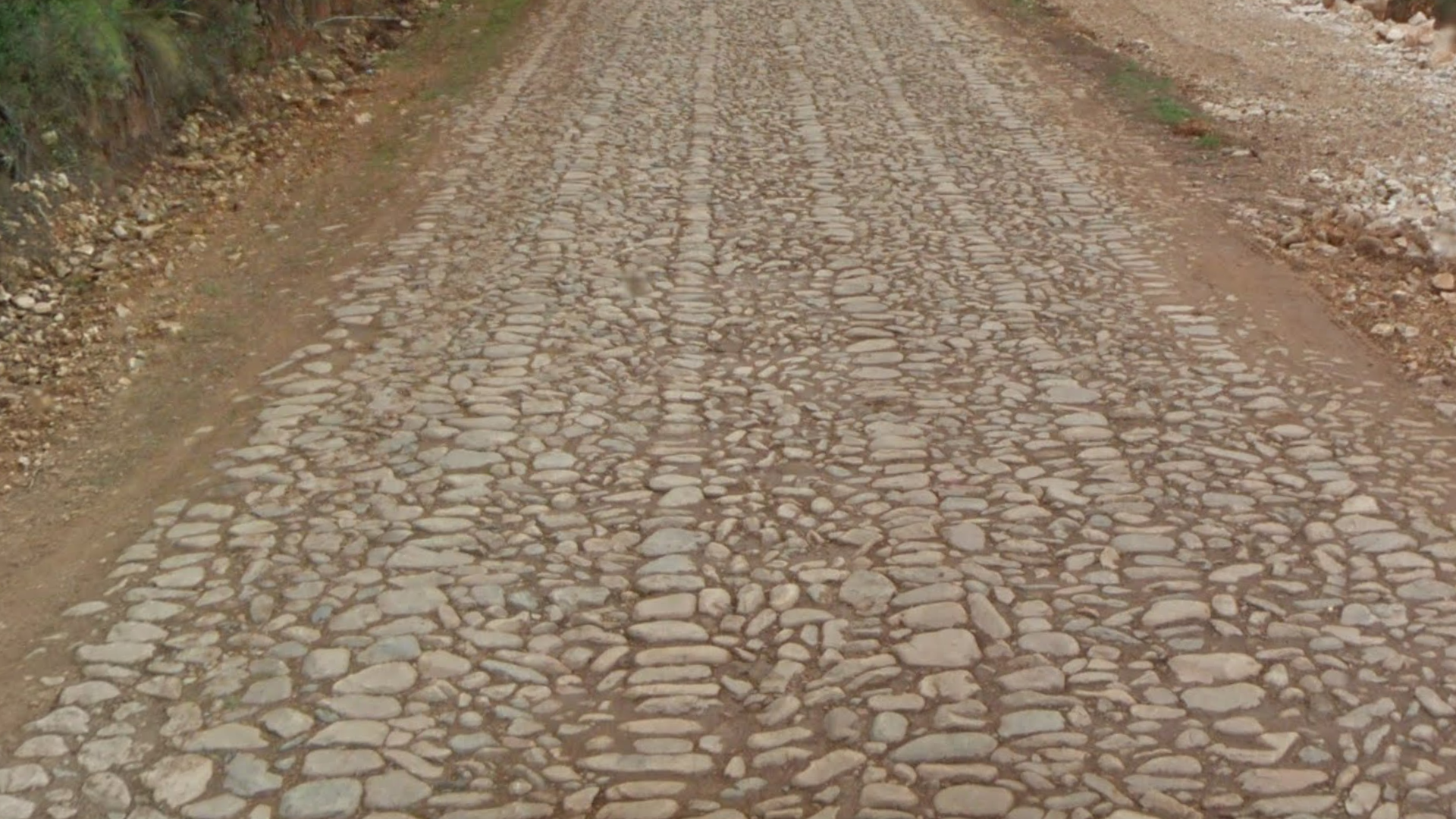
Bolivia
Middle road lines can be all-yellow, yellow and white, or all-white, while outer road lines are always white.
NOTE: Road lines in Chile are always all-white or all-yellow, never a combination of the two. In Peru, you can find roads having outer lines with no middle line. Such outer line-only roads are very rare in Bolivia.
Two types of utility poles are common in Bolivia:
Round concrete poles, often with small pinholes near the top.
Wooden poles.
Poles in Bolivia are very inconsistent and should not be relied on too much. Poles can have a variety of pole tops. On rare occasions, you can find Argentina-style concrete poles.
Kilometre markers are black and white. The top part is black and features the abbreviation ‘Km’, while the bottom part is white and shows the distance. These markers do not have road numbers.
NOTE: They can look somewhat similar to Argentinian road markers, especially from a distance. The main difference is that the markers in Argentina feature a road number.
Many Bolivians wear traditional clothing, especially women. Folk dress for women typically consists of bowler hats, colourful shawls, and big pleated skirts (pollera).
NOTE: Similar folk dress can sometimes be found in parts of Peru, especially those close to Bolivia.
Bolivia’s ruling political party is called Movimiento al Socialismo (MAS). Political graffiti often features the words MAS and Evo, short for Evo Morales, who was president of Bolivia at the time the country was covered by Street View.
Additionally, many random objects are painted in the party’s colours: black, white, and a large blue field. This distinctive colour scheme is a good clue for Bolivia.
Bolivia has a second official flag, called the Wiphala. It is a square patchwork of seven diagonally arranged colours. It is sometimes seen on government buildings and project signs.
In urban areas, you will often see ads for the telecom company Tigo, with its distinct blue logo. Crucially, this company does not operate in Peru, meaning it can help you solve urban 50-50s.
NOTE: This company does operate in several other Latin American countries, so only use this tip to differentiate between Peru and Bolivia.
If all else fails, and you have a tough 50-50, it can help to look at the colour of the rocks and soil, which often have a distinct reddish tint in Bolivia, more so than the other Andean countries.
This information should be used with a fair amount of caution, as there are many variables. Only use it when you have no other clues available.
Coverage in Bolivia is very limited, both in geographic scope and the density of roads covered.
Only the central and central-western parts of the country have coverage. Most coverage is found in and around the six main cities of La Paz or El Alto, Cochabamba, Oruro, Sucre, Potosi, and Santa Cruz.
These aforementioned six cities have in-depth side-street coverage. Outside these cities, coverage is mostly limited to main roads. Beware that “main road” is a relative concept in Bolivia: many of these, even some that are marked yellow on the map, have large unpaved sections.
The Altiplano (“high plain”) is an immense highland plateau that dominates most of western Bolivia. It is covered in grasslands that range from green to arid. Some parts are suitable for agriculture, whereas other parts are extremely dry. Grass growing in tufts is common (sometimes referred to as “Bolivian hedgehogs” in the community).
NOTE: While it is generally fairly flat, you will often see hills and mountains around you. However, as a general rule, the road itself will be mostly flat.
Conversely, the Altiplano looks more arid in the more southern half: around Oruro, and the roads going southwest towards Chile.
NOTE: There is one major exception to this: one driving side of the divided part of Ruta 1 looks somewhat green all the way up to Oruro (due to this coverage being captured in a different season).
Lake Titicaca, on the border with Peru, is the most significant body of water in Bolivia. It is located entirely within the Altiplano. It can be seen from two roads:
The section of Ruta 1 between Desaguadero and Guaqui. Here, the lake will always be to your north.
The section of Ruta 2 between San Pablo de Tiquina and Batallas. Here, the lake will mostly be to your south or west.
The landscape around Titicaca is very green, compared to most of the western half of Bolivia.
The area east of the Andes is very green and tropical, with lots of agriculture – especially around Santa Cruz. This area is mostly very flat, though you will see large hills on some of the roads closer to the Andes. The soil tends to have a pink colour.
Only a couple of cities and towns in Bolivia have a lot of sidestreet coverage. Most of the cities can be easily and consistently distinguished from each other using a few basic tips.
El Alto is situated on a very flat, highland plateau. It looks much drier and dustier than La Paz. The layout of its streets is also more regular and grid-like.
The city appears like an unending mess of semi-finished red brick buildings, even more so than other cities in Bolivia. Some neighbourhoods have a very rundown, desolate look.
In El Alto, you can sometimes see a local type of architecture referred to as Neo-Andean. Buildings in this style are colourful, with elaborate, futuristic-looking façades. The style is really unique and is almost completely limited to El Alto.
Of all the major cities in Bolivia, Oruro is situated in by far the most dry landscape.
In Oruro, you will also usually be able to see a large dry hill to your west, in an otherwise mostly flat and very arid landscape.
NOTE: Potosí is also located in an arid landscape. However, it is considerably hillier.
Ruta 1 west of El Alto is a paved road that runs through green grasslands. The road itself is mostly flat, but you will usually see hills nearby. On the road, you will often see numbers marked in white paint.
Near the western end of the road, close to Desaguadero and the border with Peru, you will be able to see Lake Titicaca to your north.
NOTE: This road can look very similar to Ruta 2 northwest of El Alto. Road angles can help if you are not sure.
The section of Ruta 3 around Pongo, northeast of La Paz, can easily be recognised by the breathtaking views of enormous mountains, which are often surrounded by low-hanging clouds. The mountains are also recognizable by their dark grey rocks lightly covered in greenish grass.
The N Yungas Road (also popularly known as Death Road), is a bendy, small and unpaved road, high up in the mountains east of La Paz. The vegetation is very tropical. The coverage in the southern part of the road is very foggy. True to its unofficial name, this road looks like a very dangerous drive. You can sometimes see some daring cyclists.
NOTE: The northern half of this road looks less foggy and dangerous. However, it should still be recognizable, as it is the only dirt road meandering through jungle hills in Bolivia.
Ruta 1 and 4 between La Paz and Oruro is a large divided highway that runs through the Altiplano landscape of western Bolivia.
It is the only large, divided highway in the entire country. There are smaller, divided roads in and near some urban areas, but those should be easily distinguishable based on landscape and road size.
Around Morochata, northwest of Cochabamba on Ruta 25, there is a small isolated piece of coverage that looks extremely similar to Peru. It is a dirt road that meanders through a mountainous landscape. Knowing this road can be extremely helpful for country streak purposes.
The western part of this road is located in a green mountain landscape, with fields on the mountain slopes and lots of eucalyptus trees around.
Towards the east, it transitions into a more arid high altitude landscape that still looks very similar to Peru.
Ruta 1 between Machacamarca and Guindal runs through an arid landscape where you will often see patches of snow on the hilltops, and sometimes even next to the road. Weather conditions range from cloudy to fully overcast, lending this coverage a gloomy look.
The aforementioned road can be regionguessed even more precisely. See the next two tips.
The section north of Challapata runs in a general NNW direction, with straight roads in flat terrain, with hills on one or both sides. Weather conditions are a little bit better, with some of the sky visible, especially when looking south.
The section of Ruta 7 between Mairana and the outskirts of Santa Cruz has coverage with a camera bug that causes a visual glitch. It is a distinctive, neon-like discoloration, that (depending on the road angle) is usually more or less to your north.
NOTE: This glitch can also rarely be found in some limited areas in and around Santa Cruz. In these areas, the glitch is often not as severe.
The roads around the town of Mataral have recognizable coverage: a very green, hilly landscape, and sunny weather with only a couple of clouds. While the hills are very green, the vegetation is not very dense, and quite low.
This coverage is limited to Ruta 7 from Comarapa to Mairana, and Ruta 22 to Vallegrande. Other roads in Bolivia with similar vegetation tend to either have different weather (overcast) or terrain (more flat).
On the southwesternmost section of Ruta 4, you can usually see the Nevado Sajama, an isolated snow-capped volcano that is very distinct and unlike any other mountain in Bolivia.
When you see Sajama, you will always be south of Callapa and the Desaguadero River. However, you will not always be able to see it on this section of the road, as it is often hidden by hills.
NOTE: The only other place where you can see Nevado Sajama is coverage in the National Park, which is recognizable by its unique Google car.
Between the villages of Villa Catalina and Coipasa, there is an isolated stretch of coverage where the Google car drove through extremely arid desert terrain. This small road is located close to the southwestern end of Ruta 12, near the Chilean border. It can be hard to spot on the map, because it blends in with the salt flat.
Closer to Villa Catalina, the car drove over the salt flat. Closer to Coipasa, the car drove on an unpaved dirt road, where you can see cone-shaped volcanic hills. In both parts, there is virtually no vegetation.
Sajama National Park was covered by this unique Google car: it has a black roof rack with a series of metal bars.
The coverage is on an unpaved road surrounded by fluffy bushes. The Nevado Sajama volcano is always visible. The car briefly drove through the small village of Tomarapi, which can be recognized by its traditional buildings with adobe walls and thatched roofs.
GeoGuessr’s own official maps are not very good, for a variety of reasons. Plonk It recommends the following maps instead:



























































